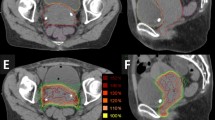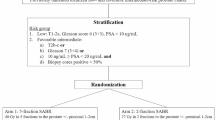Abstract
Purpose:
Aim of this analysis was to assess the current status of prostate cancer radiotherapy in Austria and compare these numbers to patients treated with surgery.
Material and Methods:
A questionnaire was sent to all 14 Austrian departments asking about numbers of prostate cancer patients treated and indication of treatment (primary, postoperative), as well as the treatment technique used (3D-CRT, IMRT, brachytherapy), treatment volumes (with/without pelvic irradiation), dose applied, and differences in treatment concepts. Data investigated were based on the year 2007.
Results:
Of the 14 departments (65%), 9 departments decided to participate. A total of 1,191 prostate cancer patients were treated (847 primary, 344 postoperative). Primary patients were treated by external beam technique (91%) and permanent interstitial brachytherapy (9%). All postoperative patients were treated by 3D-CRT. Dose ranged from 70–78 Gy for primary pa-tients and from 60–72 Gy for postoperative patients. A risk-adapted dose prescription was performed in 5 centers. Additional pelvic lymph node irradiation was based on signs of positive nodes in 4 departments and based on Roach formula/Partin table in 5 departments.
Conclusion:
About 25% of prostate cancer patients receive primary radiotherapy. This number reflects a high potential to conduct national studies. Treatment technique and dose applied was in all centers investigated in accordance with the German S3 guidelines.
Zusammenfassung
Ziel:
Erfassung des aktuellen Status zur Strahlentherapie des Prostatakarzinoms in Österreich und Vergleich mit den Zahlen operierter Patienten.
Material und Methodik:
Alle 14 radioonkologischen Zentren erhielten, basierend auf dem Jahr 2007, einen Fragebogen zur Anzahl der behandelten Patienten, Behandlungsintention (primär/postoperativ), Behandlungstechnik (3D-CRT, IMRT, Brachy-therapie), zu Zielvolumina (mit/ohne Beckenbestrahlung), Dosis und unterschiedliche Therapiekonzepte.
Ergebnisse:
9 von 14 Zentren (65%) nahmen an der Befragung teil – Abbildung 1. Insgesamt wurden 1191 Prostatakarzinom-patienten behandelt (847 primär – 344 postoperativ). Primäre Patienten wurden zu 91% mittels Teletherapie – Dosis 70–78 Gy – und 9% mittels Brachytherapie behandelt – Tabelle 1. Alle postoperativen Patienten erhielten eine Teletherapie – Dosis 60–72 Gy. Eine risikoadaptierte Dosisanpassung erfolgte in 5 Zentren. Die Beckenlymphknoten wurden in 4 Zentren bei positivem Befund und in 5 Zentren entsprechend der Roach-Formel bzw. der Partin-Tabelle mitbestrahlt.
Schlussfolgerung:
Etwa 25% aller Prostatakarzinompatienten erhielten eine primäre Radiotherapie. Diese Anzahl zeigt ein hohes Potential an Patienten für allfällige Studien. Die erfassten Daten waren in Übereinstimmung mit den deutschen S3-Leitlinien.
Similar content being viewed by others

References
Bolla M, van Poppel H, Collette L et al. Postoperative radiotherapy after radical prostatectomy: a randomised controlled trial (EORTC trial 22911). Lancet. 2005;366:572–578.
Dearnaley DP, Sydes MR, Graham JD et al. Escalated-dose versus standard-dose conformal radiotherapy in prostate cancer: first results from the MRC RT01 randomised controlled trial. Lancet Oncol 2007;8:475–487.
Deutsche Gesellschaft für Urologie (DGU) S3-Leitlinie Prostatakarzinom, Version 1.000, September 2009.
Fairley L, Baker M, Whiteway J et al. Trends in non-metastatics prostate cancer management in the Northern and Yorkshire region of England, 2000–2006. Br J Cancer 2009;101:1839–1845.
Gatta G, Zigon G, Buemi A et al. Prostate cancer in Europe at the end of 1990s. Acta Oncologica 2009;48:867–873.
Goldner G, Bombosch V, Geinitz H et al. Moderate risk-adapted dose escalation with three-dimensional conformal radiotherapy of localized prostate cancer from 70 to 74 Gy. First report on 5-year morbidity and biochemical control from a prospective Austrian-German multicenter phase II trial. Strahlenther Onkol 2009;185:94–100.
Goldner G, Dimopoulos J, Kirisits C et al. Moderate dose escalation in three-dimensional conformal localized prostate cancer radiotherapy: single-institutional experience in 398 patients comparing 66 Gy versus 70 Gy versus 74 Gy. Strahlenther Onkol 2009;185:438–445.
Guckenberger M, Flentje M. Intensity-modulated radiotherapy (IMRT) of localized prostate cancer: a review and future perspectives. Strahlenther Onkol 2007;183:57–62.
Guckenberger M, Ok S, Polat B et al. Toxicity after intensity-modulated, image-guided radiotherapy for prostate cancer. Strahlenther Onkol 2010;186:535–543.
Kuban DA, Tucker SL, Dong L et al. Long-term results of the M.D. Anderson randomized dose-escalation trial for prostate cancer. Int J Radiat Oncol Biol Phys 2008;70:67–74.
Peeters STH, Heemsbergen WD, Koper PCM et al. Dose-response in radiotherapy for localized prostate cancer: results of the Dutch multicenter randomized phase III trial comparing 68 Gy of radiotherapy with 78 Gy. J Clin Oncol 2006;24:1990–1996.
Statistik Austria. Statistisches Jahrbuch 2009. (http://www.statistik.at).
Thompson IM Jr, Tangen CM, Paradelo J et al. Adjuvant radiotherapy for pathologically advanced prostate cancer: a randomized clinical trial. JAMA. 2006;296:2329–2335.
Vordermark D, Marold D, Wirth S et al. Patterns of care in the radiotherapy of prostate cancer in Northern Bavaria 1998–2000. Strahlenther Onkol 2007;183:314–320.
Wiegel T, Bottke D, Steiner U et al. Phase III postoperative adjuvant radiotherapy after radical prostatectomy compared with radical prostatectomy alone in pT3 prostate cancer with postoperative undetectable prostate-specific antigen: ARO 96-02/AUO AP 09/95. J Clin Oncol 2009;27:2924–2930.
Yoshioka Y, Suzuki O, Kobayashi K et al. External-beam radiotherapy for clinically localized prostate cancer in Osaka, Japan, 1995–2006: time trends, outcome, and risk stratification. Strahlenther Onkol 2009;185:446–452.
Author information
Authors and Affiliations
Corresponding author
Rights and permissions
About this article
Cite this article
Goldner, G., Sljivic, S., Oismueller, R. et al. Prostate Cancer Radiotherapy in Austria. Strahlenther Onkol 187, 279–283 (2011). https://doi.org/10.1007/s00066-011-2268-9
Received:
Accepted:
Published:
Issue Date:
DOI: https://doi.org/10.1007/s00066-011-2268-9



